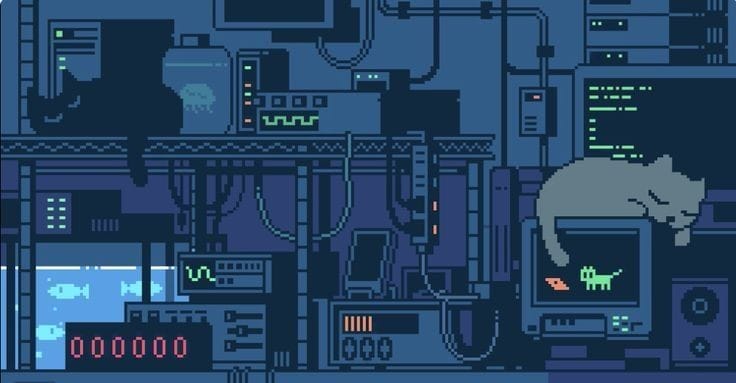Image by kacerv21 via Pinterest
When most people think of cybersecurity, they often envision an image shaped by Hollywood movies. You might picture a genius typing furiously on their keyboard, trying to breach highly encrypted systems in mere seconds. Alternatively, you might imagine shadowy figures behind anonymous masks or scenes where characters work in dimly lit rooms, their screens aglow with cascading green code that appears to be nothing more than 1’s and 0’s running across the screen. Movies and TV shows tend to turn cybersecurity into a thrilling, action-packed spectacle featuring high-tech individuals and heroic hackers, known in the real world as Ethical Hackers saving the day. While these portrayals capture a certain dramatic flair, they often misrepresent the true nature of cybersecurity and its vital role in our lives.
In reality, cybersecurity is an integral part of our daily existence, though its presence may not always be obvious. It is a complex and multifaceted field that extends beyond the flashy hacking scenes depicted in movies. It requires cybersecurity professionals to work together and continuously study due to the many new and evolving threats that arise every day. Think of it as akin to a doctor’s constant need for ongoing education. Individuals in the cybersecurity field must engage in similar continuous learning. Threats come in various forms, such as phishing attacks, ransomware, and malware, each requiring specialized tools and techniques to detect and mitigate. Cybersecurity experts do not rely on quick, on-the-fly code to save the day; instead, they utilize sophisticated technologies like firewalls, intrusion detection and prevention systems, encryption protocols, policies, and even artificial intelligence, among others, to prevent breaches. Unlike the Hollywood myth of hacking occurring within seconds, real-world cyberattacks involve extensive planning and research because this field is ever-changing. This means that events can unfold rapidly, even overnight while you are sleeping.
Hollywood has popularized many misconceptions about cybersecurity, which can distort people’s understanding of the field. A common myth perpetuated by Hollywood is that hacking happens instantaneously. However, that is not the case. Cyberattacks are often slow and methodical. Hackers may spend weeks or even months examining systems, gathering information, and exploiting vulnerabilities before launching an attack. Another myth is the lone genius hacker, whereas in reality, many hackers work together in organized groups. They use collaborative strategies to target multiple systems simultaneously. Hollywood’s portrayal might also lead people to assume that cyberattacks always involve stealing government secrets. While such scenarios add thrill to movie plots, most cyberattacks target everyday businesses, individuals, and small businesses, aiming to steal data, disrupt operations, or demand ransom.
Cybersecurity plays a crucial role in our everyday lives. For individuals, personal cybersecurity involves basic yet essential practices such as creating strong passwords, enabling two-factor authentication (2FA), and regularly updating software to patch vulnerabilities. Simple actions like being cautious of suspicious emails or avoiding unsecured public Wi-Fi networks can significantly reduce the risk of falling victim to a cyberattack. The importance of a holistic approach to cybersecurity was starkly illustrated by the global IT outage experienced by CrowdStrike on July 19, 2024. This incident was caused by a malfunction in a software update, which led to a system failure known in IT circles as the “Blue Screen of Death.” This failure highlighted the critical need for thorough testing before deploying updates. Proper testing ensures that software updates do not introduce new vulnerabilities or cause unexpected issues, thereby preventing widespread disruptions.
In the case of the CrowdStrike outage, the lack of sufficient pre-deployment testing led to significant consequences: hospitals were unable to perform surgeries, flights were canceled, and many employees were unable to work. Such incidents underscore why cybersecurity is a critical concern for everyone. Protecting both digital and physical assets from unauthorized access, whether malicious or accidental, is essential for maintaining operational integrity and safeguarding sensitive information. As technology continues to evolve, staying informed and vigilant is key to navigating the complexities of modern cybersecurity and ensuring robust protection in an increasingly interconnected world.
As we advance in the technology age, the challenges in cybersecurity evolve as well. Emerging threats such as artificial intelligence, quantum computing, and vulnerabilities in the Internet of Things (IoT) are creating new challenges for cybersecurity experts. We play a crucial role in safeguarding data and infrastructure, and nowadays, our work is increasingly intertwined with artificial intelligence, machine learning and automation to help identify and mitigate threats faster. As the digital world grows, the need to be more innovative and forward-thinking in our approach becomes even more critical.
In conclusion, cybersecurity is far more complex than Hollywood portrays. It involves ongoing efforts to protect both personal and organizational assets from evolving threats. By understanding the real-world importance of cybersecurity, we can take simple yet effective actions, such as using strong passwords or passphrases and enabling two-factor authentication, to protect ourselves from hackers. Everyone has a role to play in creating a safer digital environment. Let’s start today by being proactive about your own cybersecurity and encouraging others to do the same.
~(Cyber Girl)





